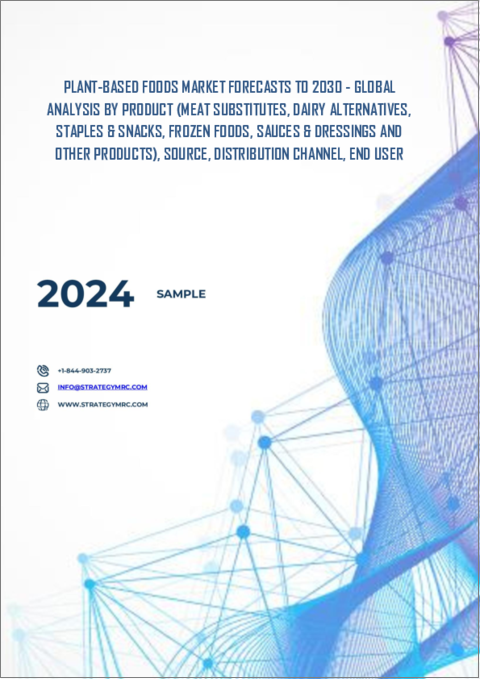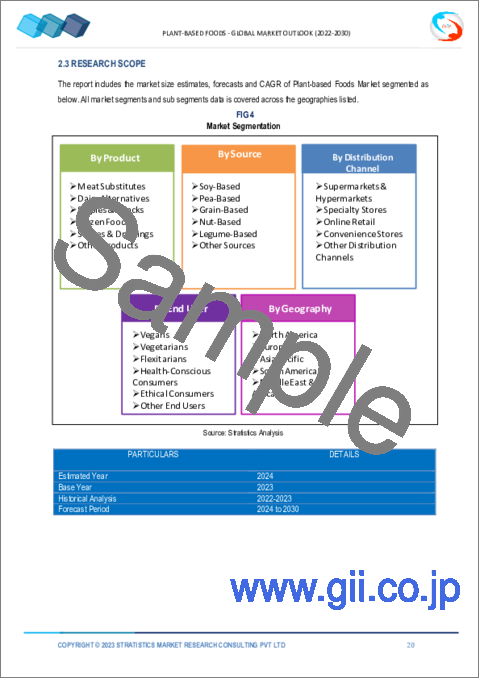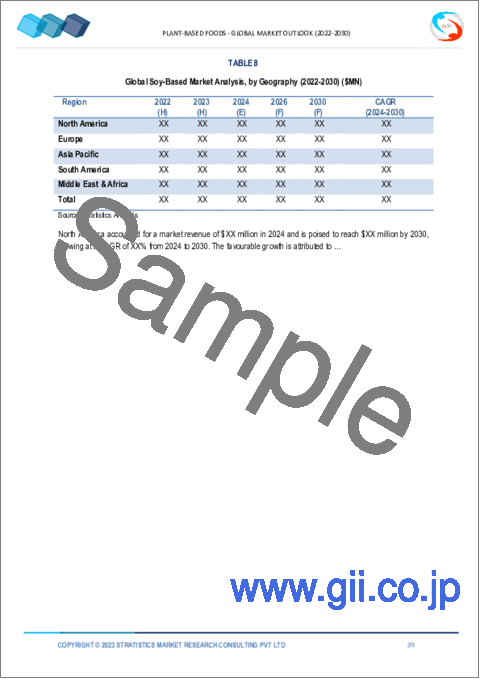|
|
市場調査レポート
商品コード
1530822
植物性食品市場の2030年までの予測:製品別、原料別、流通チャネル別、エンドユーザー別、地域別の世界分析Plant-based Foods Market Forecasts to 2030 - Global Analysis By Product (Meat Substitutes, Dairy Alternatives, Staples & Snacks, Frozen Foods, Sauces & Dressings and Other Products), Source, Distribution Channel, End User and By Geography |
||||||
カスタマイズ可能
|
|||||||
| 植物性食品市場の2030年までの予測:製品別、原料別、流通チャネル別、エンドユーザー別、地域別の世界分析 |
|
出版日: 2024年08月01日
発行: Stratistics Market Research Consulting
ページ情報: 英文 200+ Pages
納期: 2~3営業日
|
全表示
- 概要
- 図表
- 目次
Stratistics MRCによると、世界の植物性食品市場は2024年に122億4,000万米ドルを占め、予測期間中にCAGR 14.5%で成長し、2030年には329億8,000万米ドルに達する見込みです。
植物ベースの食品は、完全に植物に由来し、動物性食品は除外されています。こうした食品は、コレステロールの低下や慢性疾患のリスクの低減といった健康上の利点から選ばれることが多いです。植物ベースの食事はまた、畜産に関連するエコロジカル・フットプリントを削減することにより、環境の持続可能性をサポートすることもできます。全体的な健康を促進しながら必要な栄養素を摂取するために、加工を最小限に抑えた丸ごとの食材が重視されます。
オックスフォード・マーティン・スクールの研究者が行った調査によると、野菜や果物をより多く摂取し、肉類を減らす食生活への転換は、2050年までに約800万人の命を救うことができるといいます。
動物福祉と倫理問題への関心の高まり
工業的畜産における非人道的な環境に対する意識は、動物による搾取を避ける食生活を求める人々を駆り立てています。植物由来の食品は、倫理的価値観に沿った思いやりのある選択肢を提供し、動物の権利を促進します。このような倫理意識の高まりは、消費者が自分の価値観を反映した選択肢を選ぶようになっていることから、植物由来の製品に対する需要を牽引しています。その結果、企業は植物由来の製品を拡大し、この需要に対応するための技術革新を進め、市場の成長とアクセシビリティをさらに促進しています。
栄養面での懸念
植物由来の食品における栄養面での懸念は、タンパク質、ビタミンB12、鉄分、カルシウム、オメガ 3系脂肪酸などの必須栄養素が欠乏する可能性から生じる。こうした懸念は、消費者が植物ベースの食生活を全面的に採用することを思いとどまらせたり、栄養面での適切性についての誤解を招いたりする可能性があります。さらに、こうした栄養ニーズに対応するためには、栄養強化剤やサプリメントを追加する必要がある場合が多く、コスト増と製品開発の複雑化を招き、市場拡大にさらなる影響を与える可能性があります。
フレキシタリアンおよびベジタリアン食の人気の高まり
フレキシタリアンは、主に植物性食品を摂取するが、時折肉類も摂取するため、彼らの食生活に合った、汎用性が高くおいしい植物性食品への関心が高まる。ベジタリアンは食肉を完全に排除し、栄養ニーズを満たすために多様な植物性製品を求める。このような消費者の嗜好の高まりは、植物性製品の革新と拡大を促し、市場での入手可能性を高め、競争力のある価格設定を促進します。こうした食生活の動向は一体となって、植物性食品を求めるより多くの、より熱心な消費者を生み出し、市場の成長を促進します。
コストの上昇
植物ベースの食品におけるコストの上昇は、高価な原材料、生産プロセス、および技術投資によって生じることが多いです。こうしたコスト上昇は、使用される高級食材、特殊な製造技術、および従来の動物性製品と比較して低い規模の経済に起因します。このような価格格差は、特に価格に敏感なグループの消費者の採用を制限し、市場への浸透を制限する可能性があります。
COVID-19の影響
COVID-19は、消費者がより健康的で免疫力を高める食生活と持続可能な食品の選択肢をますます求めるようになったため、植物性食品市場を大幅に押し上げました。パンデミックによって健康と衛生に対する意識が高まり、栄養価の高さで知られる植物性食品への関心が高まった。サプライチェーンの混乱とオンライン・ショッピングの増加は、市場の成長をさらに加速させました。さらに、この危機は植物由来の食生活の環境面での利点を浮き彫りにし、より持続可能で植物に重点を置いた食生活へと消費者の嗜好が長期的にシフトする一因となった。
予測期間中、大豆ベース・セグメントが最大となる見込み
大豆ベースのセグメントは有利な成長を遂げると推定されます。大豆ベースの植物性食品は動物性食品の代替品として人気があり、タンパク質が豊富な幅広い選択肢を提供しています。主な大豆ベースの製品には、豆腐、テンペ、豆乳、枝豆などがあります。これらの食品は、高タンパク質、必須アミノ酸、調理の多様性で評価されています。大豆ベースの食品は、コレステロール値の低下や心臓の健康増進にも貢献しています。大豆製品に対する需要の高まりは、その手頃な価格、栄養面での利点、様々な料理への適応性によってもたらされ、植物性食生活の主食となっています。
菜食主義者セグメントは予測期間中最も高いCAGRが見込まれる
菜食主義者セグメントは予測期間中に最高のCAGR成長が見込まれます。菜食主義者の用途では、動物性食品を一切排除した食生活の中核をなす植物性食品が不可欠です。これらの食品は、倫理的、環境的、健康的な動機に沿いながら、タンパク質、ビタミン、ミネラルなどの重要な栄養素を提供します。植物性食品の多様性と革新性は、多様な料理嗜好と栄養ニーズに対応し、バランスのとれた充実した菜食主義者のライフスタイルを支えています。
最大のシェアを持つ地域:
アジア太平洋地域の植物性食品市場は、健康意識の高まり、食生活のシフト、環境問題への関心の高まりによって急速に拡大しています。中国、インド、日本などの国々では、製品の入手しやすさの向上、革新的な製品の提供、持続可能な食生活を推進する政府の取り組みにより、植物ベースの食生活の採用が増加しています。この地域の多様な料理の伝統とビーガンやベジタリアンの人口増加が市場の成長を促進しています。さらに、伝統的な料理における植物性代替食品の台頭が、市場への浸透と消費者の受容を高めています。
CAGRが最も高い地域:
北米では、健康上のメリット、環境の持続可能性、動物福祉に関する倫理的関心に対する消費者の意識の高まりが原動力となって、植物ベースの食品市場が力強い成長を遂げています。乳製品や肉の代替食品を含む植物ベースの製品の種類が増え、小売店が広く利用できるようになったことが、この拡大を後押ししています。企業による技術革新とマーケティングへの高水準の投資も市場の成長に寄与しています。さらに、フレキシタリアン食の台頭と食生活の包括性が、植物由来の選択肢に対する需要をさらに後押ししています。
無料のカスタマイズ提供:
本レポートをご購読のお客様には、以下の無料カスタマイズオプションのいずれかをご利用いただけます:
- 企業プロファイル
- 追加市場プレイヤーの包括的プロファイリング(3社まで)
- 主要企業のSWOT分析(3社まで)
- 地域セグメンテーション
- 顧客の関心に応じた主要国の市場推計・予測・CAGR(注:フィージビリティチェックによる)
- 競合ベンチマーキング
- 製品ポートフォリオ、地理的プレゼンス、戦略的提携に基づく主要企業のベンチマーキング
目次
第1章 エグゼクティブサマリー
第2章 序文
- 概要
- ステークホルダー
- 調査範囲
- 調査手法
- データマイニング
- データ分析
- データ検証
- 調査アプローチ
- 調査情報源
- 1次調査情報源
- 2次調査情報源
- 前提条件
第3章 市場動向分析
- 促進要因
- 抑制要因
- 機会
- 脅威
- 製品分析
- エンドユーザー分析
- 新興市場
- COVID-19の影響
第4章 ポーターのファイブフォース分析
- 供給企業の交渉力
- 買い手の交渉力
- 代替品の脅威
- 新規参入業者の脅威
- 競争企業間の敵対関係
第5章 世界の植物性食品市場:製品別
- 肉の代替品
- 乳製品の代替品
- 主食とスナック
- 冷凍食品
- ソース&ドレッシング
- その他の製品
第6章 世界の植物性食品市場:原料別
- 大豆ベース
- エンドウ豆ベース
- 穀物ベース
- ナッツベース
- 豆類ベース
- その他の原料
第7章 世界の植物性食品市場:流通チャネル別
- スーパーマーケットとハイパーマーケット
- 専門店
- オンライン小売
- コンビニエンスストア
- その他の流通チャネル
第8章 世界の植物性食品市場:エンドユーザー別
- ビーガン
- ベジタリアン
- フレキシタリアン
- 健康志向の消費者
- エシカルな消費者
- その他のエンドユーザー
第9章 世界の植物性食品市場:地域別
- 北米
- 米国
- カナダ
- メキシコ
- 欧州
- ドイツ
- 英国
- イタリア
- フランス
- スペイン
- その他欧州
- アジア太平洋
- 日本
- 中国
- インド
- オーストラリア
- ニュージーランド
- 韓国
- その他アジア太平洋地域
- 南米
- アルゼンチン
- ブラジル
- チリ
- その他南米
- 中東・アフリカ
- サウジアラビア
- アラブ首長国連邦
- カタール
- 南アフリカ
- その他中東とアフリカ
第10章 主な発展
- 契約、パートナーシップ、コラボレーション、合弁事業
- 買収と合併
- 新製品発売
- 事業拡大
- その他の主要戦略
第11章 企業プロファイリング
- Nestle
- Impossible Foods
- Beyond Meat
- Alpro
- Silk
- Daiya Foods
- Tofurky
- Miyoko's Creamery
- Chobani
- Ripple Foods
- Good Catch
- Numi Organic Tea
- Plantfusion
- Follow Your Heart
- Amy's Kitchen
- Oatly
- Plantaway
List of Tables
- Table 1 Global Plant-based Foods Market Outlook, By Region (2022-2030) ($MN)
- Table 2 Global Plant-based Foods Market Outlook, By Product (2022-2030) ($MN)
- Table 3 Global Plant-based Foods Market Outlook, By Meat Substitutes (2022-2030) ($MN)
- Table 4 Global Plant-based Foods Market Outlook, By Dairy Alternatives (2022-2030) ($MN)
- Table 5 Global Plant-based Foods Market Outlook, By Staples & Snacks (2022-2030) ($MN)
- Table 6 Global Plant-based Foods Market Outlook, By Frozen Foods (2022-2030) ($MN)
- Table 7 Global Plant-based Foods Market Outlook, By Sauces & Dressings (2022-2030) ($MN)
- Table 8 Global Plant-based Foods Market Outlook, By Other Products (2022-2030) ($MN)
- Table 9 Global Plant-based Foods Market Outlook, By Source (2022-2030) ($MN)
- Table 10 Global Plant-based Foods Market Outlook, By Soy-Based (2022-2030) ($MN)
- Table 11 Global Plant-based Foods Market Outlook, By Pea-Based (2022-2030) ($MN)
- Table 12 Global Plant-based Foods Market Outlook, By Grain-Based (2022-2030) ($MN)
- Table 13 Global Plant-based Foods Market Outlook, By Nut-Based (2022-2030) ($MN)
- Table 14 Global Plant-based Foods Market Outlook, By Legume-Based (2022-2030) ($MN)
- Table 15 Global Plant-based Foods Market Outlook, By Other Sources (2022-2030) ($MN)
- Table 16 Global Plant-based Foods Market Outlook, By Distribution Channel (2022-2030) ($MN)
- Table 17 Global Plant-based Foods Market Outlook, By Supermarkets & Hypermarkets (2022-2030) ($MN)
- Table 18 Global Plant-based Foods Market Outlook, By Specialty Stores (2022-2030) ($MN)
- Table 19 Global Plant-based Foods Market Outlook, By Online Retail (2022-2030) ($MN)
- Table 20 Global Plant-based Foods Market Outlook, By Convenience Stores (2022-2030) ($MN)
- Table 21 Global Plant-based Foods Market Outlook, By Other Distribution Channels (2022-2030) ($MN)
- Table 22 Global Plant-based Foods Market Outlook, By End User (2022-2030) ($MN)
- Table 23 Global Plant-based Foods Market Outlook, By Vegans (2022-2030) ($MN)
- Table 24 Global Plant-based Foods Market Outlook, By Vegetarians (2022-2030) ($MN)
- Table 25 Global Plant-based Foods Market Outlook, By Flexitarians (2022-2030) ($MN)
- Table 26 Global Plant-based Foods Market Outlook, By Health-Conscious Consumers (2022-2030) ($MN)
- Table 27 Global Plant-based Foods Market Outlook, By Ethical Consumers (2022-2030) ($MN)
- Table 28 Global Plant-based Foods Market Outlook, By Other End Users (2022-2030) ($MN)
Note: Tables for North America, Europe, APAC, South America, and Middle East & Africa Regions are also represented in the same manner as above.
According to Stratistics MRC, the Global Plant-based Foods Market is accounted for $12.24 billion in 2024 and is expected to reach $32.98 billion by 2030 growing at a CAGR of 14.5% during the forecast period. Plant-based foods are derived entirely from plants and exclude animal products. These foods are often chosen for their health benefits, such as lower cholesterol and reduced risk of chronic diseases. Plant-based diets can also support environmental sustainability by reducing the ecological footprint associated with animal farming. The emphasis is on whole, minimally processed ingredients to provide essential nutrients while promoting overall well-being.
According to a study conducted by Oxford Martin School researchers, global switch to diets that depend more on vegetables and fruit and less on meat can save around 8 million lives by 2050.
Market Dynamics:
Driver:
Rising concerns about animal welfare and ethical issues
Awareness of the inhumane conditions in industrial animal farming prompts individuals to seek diets that avoid animal exploitation. Plant-based foods offer a compassionate choice, aligning with ethical values and promoting animal rights. This growing ethical consciousness drives demand for plant-based products, as consumers increasingly choose options that reflect their values. Consequently, companies are expanding their plant-based offerings and innovating to meet this demand, further fueling market growth and accessibility.
Restraint:
Nutritional concerns
Nutritional concerns in plant-based foods arise from potential deficiencies in essential nutrients like protein, vitamin B12, iron, calcium, and omega-3 fatty acids. These concerns can deter consumers from fully adopting plant-based diets or lead to misconceptions about their nutritional adequacy. Additionally, addressing these nutritional needs often requires added fortifications or supplements, which can increase costs and complicate product development, further impacting market expansion.
Opportunity:
Mounting popularity of flexitarian and vegetarian diets
Flexitarians, who primarily eat plant-based but occasionally consume meat, drive interest in versatile, tasty plant-based options that fit their diet. Vegetarians, who exclude meat entirely, seek diverse plant-based products to meet their nutritional needs. This rising consumer preference encourages innovation and expansion in plant-based product offerings, enhances market availability, and promotes competitive pricing. Together, these dietary trends fuel market growth by creating a larger and more engaged audience for plant-based foods.
Threat:
Higher costs
Higher costs in plant-based foods often result from expensive raw materials, production processes, and technology investments. These elevated costs can be attributed to the premium ingredients used, specialized manufacturing techniques, and lower economies of scale compared to traditional animal-based products. This price disparity can limit consumer adoption, particularly among price-sensitive groups, and restrict market penetration.
Covid-19 Impact
Covid-19 significantly boosted the plant-based foods market as consumers increasingly sought healthier, immune-boosting diets and sustainable food options. The pandemic heightened awareness of health and hygiene, driving interest in plant-based products known for their nutritional benefits. Supply chain disruptions and a rise in online shopping further accelerated the market's growth. Additionally, the crisis underscored the environmental benefits of plant-based diets, contributing to long-term shifts in consumer preferences toward more sustainable and plant-focused eating habits.
The soy-based segment is expected to be the largest during the forecast period
The soy-based segment is estimated to have a lucrative growth. Soy-based plant foods are popular alternatives to animal products, offering a range of protein-rich options. Key soy-based products include tofu, tempeh, soy milk, and edamame. They are valued for their high protein content, essential amino acids, and versatility in cooking. Soy-based foods also contribute to lower cholesterol levels and improved heart health. The growing demand for soy products is driven by their affordability, nutritional benefits, and adaptability in various cuisines, making them a staple in plant-based diets.
The vegans segment is expected to have the highest CAGR during the forecast period
The vegans segment is anticipated to witness the highest CAGR growth during the forecast period. In vegan applications, plant-based foods are essential as they form the core of a diet that excludes all animal products. These foods provide vital nutrients such as protein, vitamins, and minerals while aligning with ethical, environmental, and health motivations. The variety and innovation in plant-based products cater to diverse culinary preferences and nutritional needs, supporting a balanced and fulfilling vegan lifestyle.
Region with largest share:
The plant-based foods market in the Asia-Pacific region is expanding rapidly, driven by rising health awareness, dietary shifts, and growing environmental concerns. Countries like China, India, and Japan are seeing increased adoption of plant-based diets due to improved product availability, innovative offerings, and government initiatives promoting sustainable eating. The region's diverse culinary traditions and increasing vegan and vegetarian populations are fueling market growth. Additionally, the rise of plant-based alternatives in traditional cuisines is enhancing market penetration and consumer acceptance.
Region with highest CAGR:
In North America, the plant-based foods market is experiencing robust growth, driven by increasing consumer awareness of health benefits, environmental sustainability, and ethical concerns regarding animal welfare. The expansion is fuelled by a growing variety of plant-based products, including dairy and meat alternatives, and widespread retail availability. High levels of investment in innovation and marketing by companies are also contributing to the market's growth. Additionally, the rise of flexitarian diets and dietary inclusivity further supports the demand for plant-based options.
Key players in the market
Some of the key players profiled in the Plant-based Foods Market include Nestle, Impossible Foods, Beyond Meat, Alpro, Silk, Daiya Foods, Tofurky, Miyoko's Creamery, Chobani, Ripple Foods, Good Catch, Numi Organic Tea, Plantfusion, Follow Your Heart, Amy's Kitchen, Oatly and Plantaway.
Key Developments:
In July 2024, Nestle has launched Maggi Rindecarne, a plant-based meat alternative designed to extend meals, in Chile. The mix of soy and spices allows consumers to prepare a dish combining meat and plant-based proteins, doubling the amount of servings at an affordable price. Additionally, it is versatile and customizable and can be used to prepare all minced meat top dishes.
In April 2024, Plantaway launched its latest addition to its portfolio - plant-based gelatos. The gelatos are made with 100% plant-based ingredients, ensuring that they are free from animal products. With no added sugar and dairy-free ingredients, these gelatos cater to consumers looking for healthier dessert options.
Products Covered:
- Meat Substitutes
- Dairy Alternatives
- Staples & Snacks
- Frozen Foods
- Sauces & Dressings
- Other Products
Sources Covered:
- Soy-Based
- Pea-Based
- Grain-Based
- Nut-Based
- Legume-Based
- Other Sources
Distribution Channels Covered:
- Supermarkets & Hypermarkets
- Specialty Stores
- Online Retail
- Convenience Stores
- Other Distribution Channels
End Users Covered:
- Vegans
- Vegetarians
- Flexitarians
- Health-Conscious Consumers
- Ethical Consumers
- Other End Users
Regions Covered:
- North America
- US
- Canada
- Mexico
- Europe
- Germany
- UK
- Italy
- France
- Spain
- Rest of Europe
- Asia Pacific
- Japan
- China
- India
- Australia
- New Zealand
- South Korea
- Rest of Asia Pacific
- South America
- Argentina
- Brazil
- Chile
- Rest of South America
- Middle East & Africa
- Saudi Arabia
- UAE
- Qatar
- South Africa
- Rest of Middle East & Africa
What our report offers:
- Market share assessments for the regional and country-level segments
- Strategic recommendations for the new entrants
- Covers Market data for the years 2022, 2023, 2024, 2026, and 2030
- Market Trends (Drivers, Constraints, Opportunities, Threats, Challenges, Investment Opportunities, and recommendations)
- Strategic recommendations in key business segments based on the market estimations
- Competitive landscaping mapping the key common trends
- Company profiling with detailed strategies, financials, and recent developments
- Supply chain trends mapping the latest technological advancements
Free Customization Offerings:
All the customers of this report will be entitled to receive one of the following free customization options:
- Company Profiling
- Comprehensive profiling of additional market players (up to 3)
- SWOT Analysis of key players (up to 3)
- Regional Segmentation
- Market estimations, Forecasts and CAGR of any prominent country as per the client's interest (Note: Depends on feasibility check)
- Competitive Benchmarking
- Benchmarking of key players based on product portfolio, geographical presence, and strategic alliances
Table of Contents
1 Executive Summary
2 Preface
- 2.1 Abstract
- 2.2 Stake Holders
- 2.3 Research Scope
- 2.4 Research Methodology
- 2.4.1 Data Mining
- 2.4.2 Data Analysis
- 2.4.3 Data Validation
- 2.4.4 Research Approach
- 2.5 Research Sources
- 2.5.1 Primary Research Sources
- 2.5.2 Secondary Research Sources
- 2.5.3 Assumptions
3 Market Trend Analysis
- 3.1 Introduction
- 3.2 Drivers
- 3.3 Restraints
- 3.4 Opportunities
- 3.5 Threats
- 3.6 Product Analysis
- 3.7 End User Analysis
- 3.8 Emerging Markets
- 3.9 Impact of Covid-19
4 Porters Five Force Analysis
- 4.1 Bargaining power of suppliers
- 4.2 Bargaining power of buyers
- 4.3 Threat of substitutes
- 4.4 Threat of new entrants
- 4.5 Competitive rivalry
5 Global Plant-based Foods Market, By Product
- 5.1 Introduction
- 5.2 Meat Substitutes
- 5.3 Dairy Alternatives
- 5.4 Staples & Snacks
- 5.5 Frozen Foods
- 5.6 Sauces & Dressings
- 5.7 Other Products
6 Global Plant-based Foods Market, By Source
- 6.1 Introduction
- 6.2 Soy-Based
- 6.3 Pea-Based
- 6.4 Grain-Based
- 6.5 Nut-Based
- 6.6 Legume-Based
- 6.7 Other Sources
7 Global Plant-based Foods Market, By Distribution Channel
- 7.1 Introduction
- 7.2 Supermarkets & Hypermarkets
- 7.3 Specialty Stores
- 7.4 Online Retail
- 7.5 Convenience Stores
- 7.6 Other Distribution Channels
8 Global Plant-based Foods Market, By End User
- 8.1 Introduction
- 8.2 Vegans
- 8.3 Vegetarians
- 8.4 Flexitarians
- 8.5 Health-Conscious Consumers
- 8.6 Ethical Consumers
- 8.7 Other End Users
9 Global Plant-based Foods Market, By Geography
- 9.1 Introduction
- 9.2 North America
- 9.2.1 US
- 9.2.2 Canada
- 9.2.3 Mexico
- 9.3 Europe
- 9.3.1 Germany
- 9.3.2 UK
- 9.3.3 Italy
- 9.3.4 France
- 9.3.5 Spain
- 9.3.6 Rest of Europe
- 9.4 Asia Pacific
- 9.4.1 Japan
- 9.4.2 China
- 9.4.3 India
- 9.4.4 Australia
- 9.4.5 New Zealand
- 9.4.6 South Korea
- 9.4.7 Rest of Asia Pacific
- 9.5 South America
- 9.5.1 Argentina
- 9.5.2 Brazil
- 9.5.3 Chile
- 9.5.4 Rest of South America
- 9.6 Middle East & Africa
- 9.6.1 Saudi Arabia
- 9.6.2 UAE
- 9.6.3 Qatar
- 9.6.4 South Africa
- 9.6.5 Rest of Middle East & Africa
10 Key Developments
- 10.1 Agreements, Partnerships, Collaborations and Joint Ventures
- 10.2 Acquisitions & Mergers
- 10.3 New Product Launch
- 10.4 Expansions
- 10.5 Other Key Strategies
11 Company Profiling
- 11.1 Nestle
- 11.2 Impossible Foods
- 11.3 Beyond Meat
- 11.4 Alpro
- 11.5 Silk
- 11.6 Daiya Foods
- 11.7 Tofurky
- 11.8 Miyoko's Creamery
- 11.9 Chobani
- 11.10 Ripple Foods
- 11.11 Good Catch
- 11.12 Numi Organic Tea
- 11.13 Plantfusion
- 11.14 Follow Your Heart
- 11.15 Amy's Kitchen
- 11.16 Oatly
- 11.17 Plantaway





